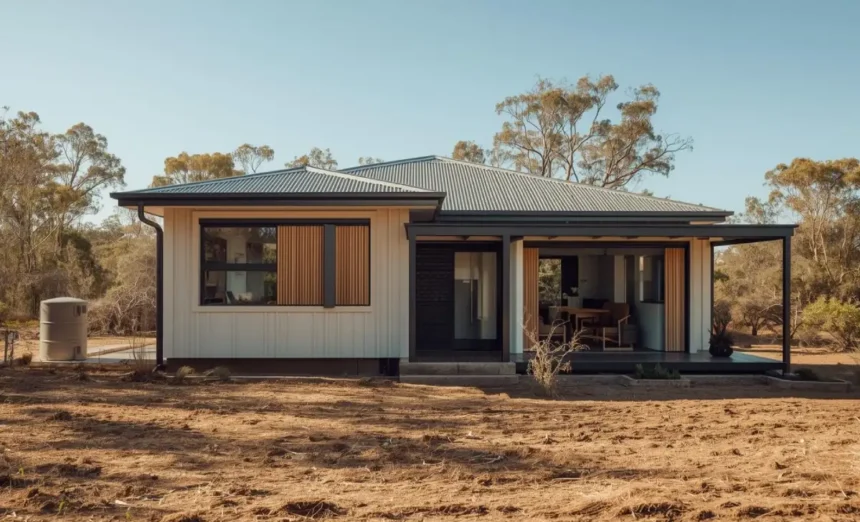Australians living in high-risk fire zones are paying up to 300% more for home insurance than those in low-risk areas. With climate change intensifying bushfire seasons and insurers tightening their belts, many homeowners face the impossible choice between adequate cover and financial stress.
- Why Bushfire Risk Drives Up Insurance Costs in Australia
- 10 Ways to Reduce Your Home Insurance Premium Bushfire Australia
- 1. Create and Maintain Defensible Space
- 2. Install Ember-Proof Building Features
- 3. Upgrade to Fire-Resistant Building Materials
- 4. Develop a Comprehensive Bushfire Action Plan
- 5. Install Smart Water Systems and Fire Suppression
- 6. Upgrade Detection and Alarm Systems
- 7. Join Community Fire Management Programs
- 8. Compare Insurers and Seek Specialist Bushfire Policies
- 9. Optimise Your Policy Structure and Excess Levels
- 10. Bundle Policies for Multi-Product Discounts
- What to Do if Insurance Remains Unaffordable
- FAQs
- How much can I realistically save on bushfire insurance premiums?
- Do I need professional assessments to qualify for insurance discounts?
- How long do premium reductions take to apply after making improvements?
- Will my premiums increase again if I stop maintaining risk reduction measures?
- Can I claim tax deductions for bushfire risk reduction improvements?
- Your Next Steps to Lower Bushfire Insurance Premiums
You don’t have to accept sky-high premiums as inevitable. Smart property upgrades, strategic policy choices, and understanding how insurers assess risk can dramatically cut your costs while keeping your home protected. This guide reveals 10 proven methods to reduce your home insurance premium in bushfire Australia, backed by real insurer requirements and government programs.
Why Bushfire Risk Drives Up Insurance Costs in Australia
Insurance companies calculate premiums based on the likelihood and cost of claims. In bushfire-prone areas, both factors work against homeowners. The Insurance Council of Australia reports that bushfire claims have increased by 78% over the past decade, with average claim costs rising from $180,000 to $320,000 per property.
Insurers use sophisticated mapping technology to assess your property’s risk level. They consider factors like vegetation density, slope, prevailing winds, and distance to emergency services. Properties in areas like the Blue Mountains, Adelaide Hills, or Perth’s outer suburbs often face premiums three times higher than metropolitan areas.
The 2019-20 Black Summer bushfires alone cost insurers $2.3 billion, leading to widespread premium increases across NSW, Victoria, and South Australia. Some regional postcodes saw increases of 40-60% in a single year. Properties previously considered moderate risk were reclassified as high risk, pushing many homeowners into unaffordable premium brackets.
Climate change projections suggest these trends will continue. The Australian Actuaries Climate Index shows fire weather risk has increased by 30% since 1990, with no signs of slowing. Understanding this context helps explain why insurers are pricing defensively and why homeowners must take proactive steps to reduce their risk profile.
10 Ways to Reduce Your Home Insurance Premium Bushfire Australia
1. Create and Maintain Defensible Space
Clearing vegetation around your home is the single most effective way to reduce bushfire risk and insurance premiums. Most insurers require a minimum 20-metre defensible space, but extending this to 40 metres can unlock additional discounts of 10-15%.
Remove all flammable materials within 10 metres of your home, including firewood, outdoor furniture, and dead vegetation. Between 10-40 metres, maintain grass below 10cm height and prune tree branches to at least 2 metres above ground. Space trees so their canopies don’t touch, preventing fire from jumping between them.
NRMA Insurance offers up to 20% premium discounts for properties with properly maintained defensible space, verified through annual inspections. QBE provides similar incentives, requiring photographic evidence of compliance submitted annually. The key is consistent maintenance – letting vegetation regrow can void your discount and increase premiums.
Document your efforts with timestamped photos showing cleared areas from multiple angles. Many insurers now accept digital submissions through their mobile apps, making the verification process simpler. Some also offer free risk assessments to identify specific improvements that could reduce your premiums.
2. Install Ember-Proof Building Features
Embers cause 90% of bushfire property damage, making ember-proofing your most cost-effective upgrade. Installing ember-proof vents, window shutters, and door seals can reduce premiums by 15-25% with most major insurers.
Replace standard roof vents with ember-proof alternatives meeting AS3959 standards. These typically cost $200-400 per vent but can save thousands annually on premiums. Similarly, retrofit window shutters or install bushfire-rated screens to prevent ember entry during fires.
A Macedon Ranges homeowner reduced their annual premium from $4,800 to $3,600 by installing ember-proof vents and door seals costing $2,800. The upgrade paid for itself within three years while providing ongoing protection. Suncorp Insurance specifically lists these modifications in their discount criteria.
Check with your local council about rebate programs for bushfire upgrades. Many Victorian councils offer grants of up to $1,000 for ember-proofing improvements, effectively reducing your out-of-pocket costs while securing long-term premium savings.
3. Upgrade to Fire-Resistant Building Materials
Using bushfire-resistant materials significantly reduces your property’s risk rating with insurers. Upgrading roofing, cladding, and decking to BAL (Bushfire Attack Level) compliant materials can lower premiums by 20-30%.
Replace timber decking with composite or steel alternatives, which resist ember ignition and don’t contribute fuel to fires. Metal roofing with appropriate ratings performs better than tiles or shingles. External walls clad in brick, stone, or fibre cement provide better protection than weatherboard or vinyl.
The Insurance Council of Australia recognises properties built or retrofitted to higher BAL standards with premium reductions. RACV Insurance offers graduated discounts based on BAL compliance levels, with BAL-40-rated properties receiving the highest discounts of up to 25%.
A Perth homeowner upgraded their weatherboard cladding to fibre cement and replaced their tile roof with metal after the 2014 Parkerville fires. Their annual premium dropped from $6,200 to $4,200, while the $18,000 upgrade improved their home’s value by $35,000. The combined financial benefits justified the initial investment within four years.
4. Develop a Comprehensive Bushfire Action Plan
Having a documented, practiced bushfire action plan demonstrates risk awareness to insurers and can reduce premiums by 5-10%. Your plan should include evacuation triggers, communication protocols, and property protection strategies.
Work with your local CFA or RFS to develop a plan specific to your property’s risk profile. Include contact details for emergency services, family members, and neighbours who might assist with property protection. Identify multiple evacuation routes and predetermined safe meeting points.
Some insurers require evidence of annual plan reviews and family practice sessions. Take photos during practice evacuations and keep records of plan updates. This documentation proves your commitment to risk management and can support premium discount applications.
The NSW RFS provides free bushfire survival plan templates through their website, while the Victorian CFA offers personalised planning sessions for high-risk properties. Many insurers specifically recognise participation in these programs when calculating premiums.
5. Install Smart Water Systems and Fire Suppression
Dedicated water supplies and fire suppression systems can reduce premiums by 15-20% while providing crucial protection during fire events. Install water tanks with independent power systems and high-pressure pumps capable of delivering adequate flow for property protection.
A minimum 22,000-litre tank with twin pumps and sprinkler systems meets most insurer requirements for premium discounts. Include gutter-mounted sprinklers and perimeter systems covering key risk areas. Solar-powered pump systems ensure operation during power outages common during fire events.
Budget Insurance reduced a Healesville property’s premium by $1,200 annually after the owners installed a 30,000-litre tank system with automated sprinklers. The $8,000 installation cost was recovered through premium savings within seven years, while providing peace of mind during high fire danger periods.
Ensure your system includes both mains water connection and tank backup. Test pumps and sprinklers monthly, documenting maintenance in logbooks that insurers may request during policy reviews. Some companies offer additional discounts for monitored systems that automatically activate during fire conditions.
6. Upgrade Detection and Alarm Systems
Modern fire detection systems with monitoring services can reduce premiums by 10-15%. Install interconnected smoke alarms throughout your home, with at least one in each bedroom and living area. Add heat detectors in garages, roof spaces, and areas where smoke detectors might false alarm.
Connect your system to a 24/7 monitoring service that automatically alerts emergency services when alarms activate. This rapid response capability significantly reduces potential damage and demonstrates proactive risk management to insurers.
AAMI Insurance offers specific discounts for properties with monitored fire alarm systems, particularly in high-risk areas. The monitoring typically costs $300-500 annually but can save more than this amount in premium reductions while providing invaluable early warning capabilities.
Consider smart smoke detectors that send alerts to your mobile phone even when you’re away from home. These systems allow for immediate response and can prevent small incidents from becoming major claims. Some models integrate with smart home systems to automatically shut off gas supplies and activate sprinkler systems.
7. Join Community Fire Management Programs
Active participation in community fire management programs demonstrates collective risk reduction and can influence individual premiums. Join your local CFA brigade, fire management group, or neighbourhood watch fire safety committee.
Community programs often include group property assessments, shared equipment purchases, and coordinated fuel reduction activities. These collective efforts reduce overall area risk, which insurers consider when setting regional premium rates.
The Macedon Ranges Community Fire Guard reduced average local premiums by 8% through coordinated fuel management and early warning systems. Participants receive certificates recognising their involvement, which some insurers accept for additional premium discounts of 3-5%.
Document your participation with meeting attendance records, training certificates, and volunteer hours. Some insurers specifically reward volunteer firefighters and community safety participants with loyalty discounts that compound over time.
8. Compare Insurers and Seek Specialist Bushfire Policies
Not all insurers assess bushfire risk identically, making comparison shopping crucial for premium reduction. Some companies specialise in high-risk properties and may offer significantly better rates than mainstream insurers.
Rural specialist insurers like Elders or Landmark often provide more competitive premiums for bushfire-prone properties because they understand rural risks better than city-based companies. Their underwriters have local knowledge and may assess your specific risk reduction measures more favourably.
A Kinglake homeowner reduced their premium from $8,400 with a major insurer to $5,200 with a rural specialist, saving $3,200 annually for identical coverage. The specialist insurer recognised their extensive defensible space and water systems that the mainstream company had undervalued.
Use comparison websites like Compare the Market or speak with insurance brokers who specialise in high-risk properties. Brokers often have access to wholesale rates and can negotiate based on your specific risk reduction investments.
9. Optimise Your Policy Structure and Excess Levels
Strategic policy structuring can reduce premiums without compromising protection. Consider separating contents insurance if you live in a low-contents-risk situation, as buildings insurance typically carries the bushfire premium loading.
Increasing your excess from $500 to $1,500 can reduce annual premiums by 15-20%. For a $4,000 annual premium, this represents $600-800 in savings that accumulate over time. Ensure you can afford the higher excess if you need to claim, but remember that major bushfire claims often exceed $100,000, making the excess difference relatively minor.
Choose replacement rather than agreed value policies where appropriate. Replacement policies often have lower premiums because they eliminate over-insurance risks. However, ensure your sum insured adequately covers rebuilding costs in your specific location.
Review your policy annually and remove unnecessary add-ons like portable electronics cover if you don’t own expensive devices. Focus your coverage on genuine bushfire risks while eliminating premium components that don’t address your primary concerns.
10. Bundle Policies for Multi-Product Discounts
Combining home insurance with car, landlord, or boat insurance through the same provider typically yields 10-15% discounts on all policies. These multi-policy discounts can significantly reduce your total insurance costs while simplifying management.
Many insurers offer additional loyalty discounts for long-term customers who hold multiple policies. After five years with the same provider, you might qualify for further reductions of 5-10% on top of multi-policy savings.
Calculate total insurance costs rather than focusing solely on home insurance premiums. Sometimes a slightly higher home insurance premium with excellent multi-policy discounts results in lower overall insurance expenses across all your policies.
NRMA Insurance provides up to 15% multi-policy discounts, while Suncorp offers graduated discounts based on the number and value of combined policies. Shop around for the best total package rather than optimising individual policy premiums in isolation.
What to Do if Insurance Remains Unaffordable
When, despite all efforts, insurance remains prohibitively expensive, several support mechanisms can help. The Northern Australia Reinsurance Pool, established in 2022, aims to reduce premiums in cyclone and bushfire-prone areas by up to 30% over five years.
Contact your local financial counselling service for assistance with insurance affordability. Many councils offer emergency support programs for residents facing insurance stress, including temporary accommodation assistance and premium payment plans.
Consider community-based insurance schemes or mutual insurance arrangements where available. Some rural communities have established collective insurance pools that provide more affordable coverage through risk sharing and local knowledge.
The Australian Financial Complaints Authority can assist if you believe your premium is unfairly calculated or if an insurer has incorrectly assessed your risk reduction measures. They provide free dispute resolution services for insurance matters.
FAQs
How much can I realistically save on bushfire insurance premiums?
Most homeowners can achieve 20-40% premium reductions through combined risk reduction measures. Properties with comprehensive upgrades including defensible space, ember-proofing, and water systems, often see savings of $2,000-5,000 annually.
Do I need professional assessments to qualify for insurance discounts?
Most insurers accept photographic evidence and self-certification for basic measures like defensible space maintenance. However, structural upgrades like ember-proofing typically require certification from qualified tradespeople to qualify for maximum discounts.
How long do premium reductions take to apply after making improvements?
Simple changes like vegetation clearing can reduce premiums at your next renewal. Structural modifications may require engineering certificates and can take 6-12 months to reflect in premiums while insurers verify compliance.
Will my premiums increase again if I stop maintaining risk reduction measures?
Yes, insurers typically conduct annual reviews of high-risk properties. Allowing defensible space to regrow or failing to maintain systems will result in premium increases and may void previous discounts.
Can I claim tax deductions for bushfire risk reduction improvements?
Some improvements may qualify for tax deductions if your property generates rental income. Consult a tax professional about claiming depreciation on fire safety equipment and building modifications used for income-producing purposes.
Your Next Steps to Lower Bushfire Insurance Premiums
Living in bushfire-prone areas doesn’t condemn you to unaffordable insurance forever. The combination of smart risk reduction, strategic policy choices, and understanding insurer requirements can dramatically reduce your home insurance premium in bushfire-prone Australia while providing better protection for your family and assets.
Start with the highest-impact, lowest-cost measures like vegetation management and policy comparison shopping. Document your improvements and maintain records that demonstrate ongoing commitment to risk reduction. Many homeowners find that initial investments in fire safety pay for themselves within 2-3 years through premium savings alone.
Take action today by contacting your current insurer to discuss available discounts and getting quotes from specialist rural insurers. Your financial security and your family’s safety are worth the effort to create a more resilient, affordable insurance strategy.






